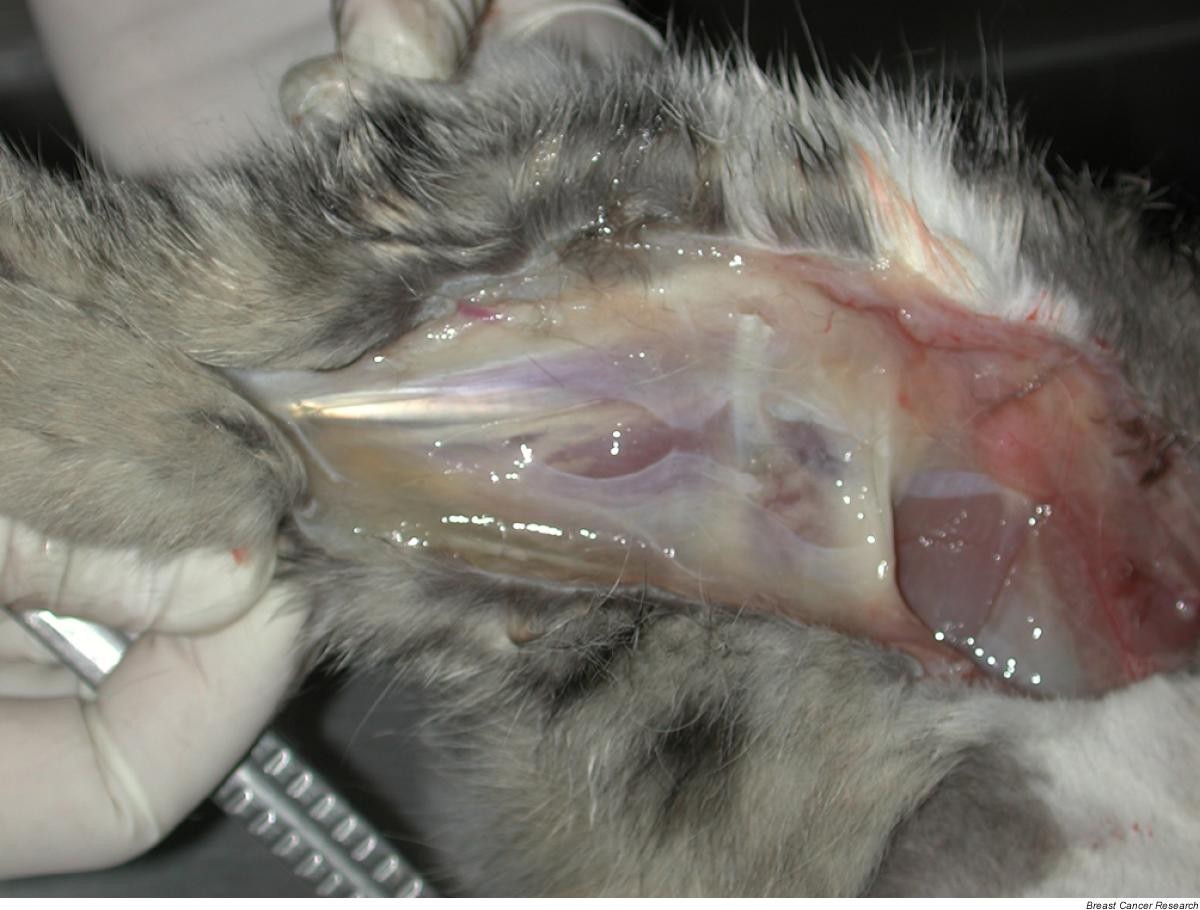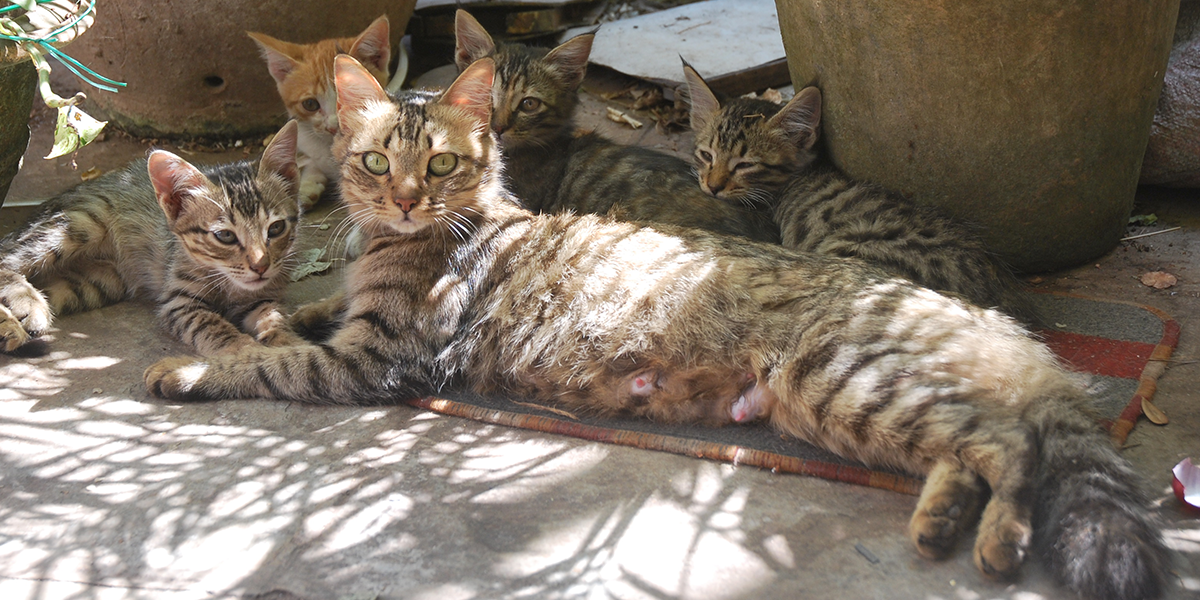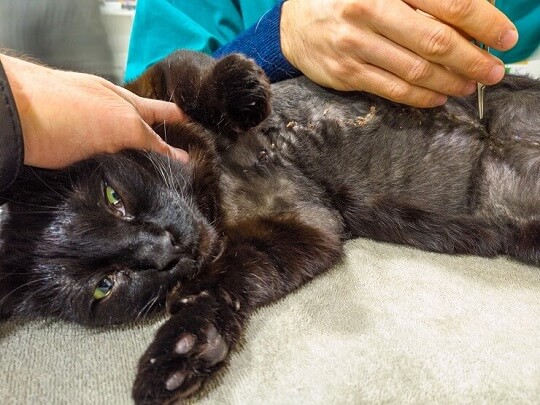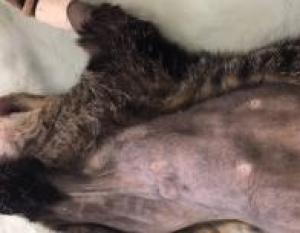mammary adenocarcinoma in cats
As the study spanned 23 years in multiple institutions histopathologic assessment was not uniform and this made it impossible to further classify the tumors by histopathologic grade or subtype. In female dogs 50 of mammary tumors are benign and 50 are malignant.

Stages Of Breast Cancer In Cats Mammary Tumors In Cats
Feline Mammary Gland Adenocarcinoma.

. Incidence of mammary tumors is dependent on when cats are spayed. A combination of these or two of them can be used. And they may occur in.
These tumors may originate in the mammary gland but they can metastasize to the lymph nodes adrenal gland lungs liver pleura and kidneys. Anaplastic carcinoma appears as an infiltrative neoplasm formed by large pleomorphic cells frequently with bizarre chromatin-rich nuclei with the presence of multinucleated cells. Biologic behavior prognostic factors and therapeutic approach in cats.
For example if the cat suffers from a malignant neoplasm but it hasnt spread to any organ chemotherapy might be initiated before the mass is removed surgically. Mammary tumors can be benign non-cancerous or malignant cancerous. Cats with tumors less than 2 cm or 8 cm 3 can have an excellent long term survival 3 years if treated with surgery alone radical mastectomy according to a prospective and retrospective studies in cats.
In cats mammary gland cancer is the equivalent of breast cancer in women. Mammary tumors in cats are usually malignant 85-93 80 of feline mammary tumors are ADC with tubular papillary solid and cribriform subtypes most common. Carcinomas often arise from the tubules of.
Cats have two chains or rows of mammary glands with four in each chain. Feline mammary carcinoma is highly malignant and generally associated with a poor prognosis although studies suggest the range of survival times in affected cats is broad. Tumor size is one of the most consistent prognostic factors in feline mammary carcinoma.
Approximately 85 of feline mammary tumors are malignant and are histologically classified as adenocarcinomas. The first sign of this type of cancer may be a fluid-filled or firm lump associated with the mammary gland or discharge originating from the nipple. The most common adenocarcinoma-associated symptoms in cats include.
Mammary cancer is usually a malignant adenocarcinoma that appears in one or more of a cats breasts. This variability diminishes the prognostic value of reported data. Histologic grading of these tumors is achieved using the Elston and Ellis.
There are several different types of mammary tumors with carcinomas being the most common. In contrast over 85 of mammary tumors in cats are malignant and most of these have an aggressive biologic behavior ie mammary tumors in cats tend to be locally invasive and spread elsewhere in the body. Sarcomas mucinous carcinomas duct papillomas adenosquamous carcinomas and adenomas are rarely seen.
Anaplastic giant cell mammary carcinoma is not frequent and has only been reported in. Approximately 200 manuscripts have been published on feline mammary tumors FMTs since the first Symposium on Mammary Neoplasia in the Dog and Cat was held at the ninth annual British Small Animal Veterinary Association congress in London in 1966. The postexcisional survival period of affected cats is inversely proportional to tumor size but the reported median survival periods for different tumor size categories is quite variable.
Females as well as males can develop this form of cancer. Mammary carcinomas and adenocarcinomas MACs are relatively common tumors in cats. Blood in the stool.
They run the length of a cats belly which means that tumors can develop anywhere from the armpit to the groin says Dr. There are also differences in both biologic behavior and histology of mammary tumors in dogs and cats. All of the cases underwent an aggressive surgery with concurrent doxorubicin-based chemotherapy.
The efficacy of a treatment combination of a COX-2 inhibitor meloxicam chemotherapy and surgery in 23 cats with histologically confirmed mammary gland adenocarcinoma was evaluated. Occurring more than 95 percent of the time in females it is the most frequently diagnosed type of feline cancer. Symptoms of adenocarcinoma in cats depend on where in the body the tumor has developed.
78 These prolonged survival times have not been reproduced by later studies. A mammary breast tumor is a common tumor in cats. Mammary cancer in cats Treatment.
Malignant mammary tumors. Other forms of breast and mammary cancer in a cat include adenomas duct papillomas and sarcomas. At a cellular level mammary tumors in dogs and cats are very similar to human breast cancer tumors says Dr.
Cat mammary gland tumors are formed by an abnormal mass of cells in the mammary breast glands. 91 Mammary tumors are common in cats and constitute approximately 17 of all feline. Most feline mammary tumors are adenocarcinomas with tubular or papillary types more common than solid or mucoid types.
Tumors originating in these glands account for the third most common type of feline cancer after lymphoma and skin cancer. Localized pain or discomfort Palpable growth. Glandular adenocarcinoma often appears in the salivary glands where it quickly metastasizes to other areas of the body.
Mammary tumors are the third most common feline cancer 1-3 accounting for 103 to 12 of all diagnosed tumors. They can be benign noncancerous or malignant cancerous. Approximately 90 of mammary tumors are malignant in cats and cats have fewer complex and mixed tumors than dogs.
Mammary gland tumors are most common in middle-aged and older female cats but they can occur in younger female cats as well as male cats. Meloxicam was given orally starting the day after surgery and was continued. Invasion ulceration lymphatic invasion and lymph node metastasis is common.
Mucus in the stool. These masses do not tend to be painful but can be associated with increased grooming behavior if discharge is present. Sarcoma SCC and mucinous carcinoma subtypes are less common.
Cancer is treated using three types of therapy surgery chemotherapy and radiation therapy. On histopathologic evaluation tumors from all 107 cats were identified as mammary carcinomas and most were labeled adenocarcinoma. However few of the malignant mammary tumors are fatal.
Cats who are spayed prior to 6 months of age have a 91 reduced risk of developing mammary cancer. Reluctance to remain active. Cancer in general afflicts an estimated 30 percent to 40 percent of all cats and one-third or so of these malignancies involve the mammary glands.
Mammary tumors are the third most common feline cancer1-3 accounting for 103 to 12 of all diagnosed tumors124 Female cats are. In cats the vast majority of mammary tumors are malignant. When it appears in cats it can be fatal even if treated with surgery radiation and chemotherapy.
Scott Coonrod the Judy Wilpon Professor of Cancer Biology and director of the Baker Institute for Animal Health. These two forms of the disease have different diagnostics treatments management and prognosis. Feline mammary gland tumors are the 3 rd most common feline tumor and are most commonly diagnosed in middle-aged to older cats.
Another type of adenocarcinoma affects female cats.

Feline Mammary Cancer Mammary Tumors Common In Cats Especially Those Unspayed Or Spayed Late In Life Palm Beach Florida Weekly

Mammary Cancer In Cats Veterinary Partner Vin

Victoria Stilwell October Is Breast Cancer Awareness Month Did You Know That Cats And Dogs Especially Intact Females Are Susceptible To Mammary Cancer As Well This Is A Great Graphic From

Cat Breast Cancer Causes Symptoms And Treatment Of Mammary Cancer
Did You Know Dogs And Cats Get Breast Cancer Granville Vetgranville Vet

Mammary Carcinoma International Cat Care

A Clinical Manifestation Of Mammary Fibroadenomatous Hyperplasia B Download Scientific Diagram

Breast Cancer In Cats Causes Symptoms Treatment All About Cats

Cat Got Mammary Gland Tumor And Removed In 2016 09 I Spotted A Lump Ish Thing On Her Other Side Of Belly In 2018 01 Went To The Vet Petcoach

Malignant Mammary Tumors Biologic Behavior Prognostic Factors And Therapeutic Approach In Cats

First Description Of Feline Inflammatory Mammary Carcinoma Clinicopathological And Immunohistochemical Characteristics Of Three Cases Breast Cancer Research Full Text

Spotlight On Feline Mammary Cancer Dr Sue Cancer Vet Facebook

Cancer In Cats Causes Symptoms Treatments Canna Pet

Mammary Hypertrophy In Cats Reproductive System Merck Veterinary Manual

Cat Breast Cancer Causes Symptoms And Treatment Of Mammary Cancer

Melissa S Mochas Mysteries And Meows The Purrfect 10 Things To Know About Breast Cancer In Cats
